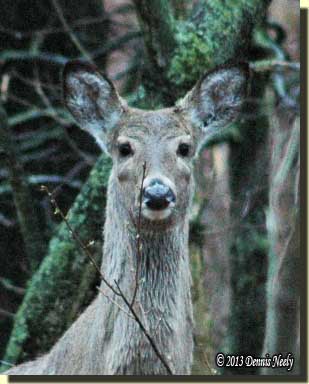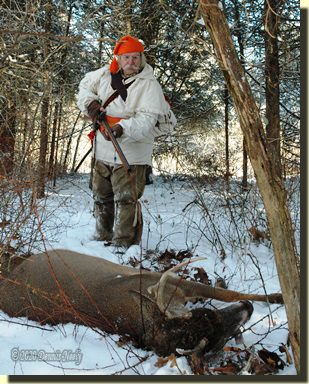Two blue jays flew across the trail. The first perched high in a red oak, the second lower on a cedar bough. Wool-line moccasins paused. “Swip-it…swip-it…swip-it,” the birds bantered back and forth, in a contented tone.
“Kee-honk, kee-honk, yonk, yonk…” Five Canada geese flew overhead. The blue jays swooped to the west, in the direction of the River Raisin. The still-hunt progressed up the rise. Winter moccasins whispered along the doe trail that wove through the cedar trees on the east face of the long ridge.
In due course, a tangle of ice-downed cedar trees offered a promising lair. Four trails meandered along the slope in a north-south direction. Others, utilized more at first light and again at dusk than during the day, angled up and down the steep hillside.
A moccasin toe scuffed away the leaves and duff. The aroma of fresh-plowed earth filled the nest, hacked out with judicious blows of a forged ax the fall after the trees met their doom. A wool trade blanket, rolled tight and bound with the tails of a leather portage collar, dropped into the depression.

A gentle breeze drifted from the big swamp’s cut bank at the base of the hill. A woodsman’s scent tended to filter into the dead limbs, raspberry switches and withered nettles. Despite the wind direction, deer seldom became alarmed beyond twenty-five paces. Ten minutes or so after settling in, a stomp to the down-wind side of the brushy mess seemed to dispel the scent-neutral belief.
The deer remained unseen; only the occasional stomp belied its existence on that November day, in the Year of our Lord, 1796. A red-tailed hawk screeched overhead. A blue jay, somewhere to the north, uttered the same song as the earlier birds: “Swip-it…swip-it…swip-it…”
In time an ear twitched in the hunter’s periphery. A foreleg stepped, then the left. Shoulder muscles rippled. The old doe’s head bobbed, trying to force an unknown intruder to move and give away his or her location. This little dance with danger proceeded past four or five large cedar trees. A summer fawn followed, showing less concern.
The younger deer broke into a fast walk, passing its dam as it approached the ridge crest. A button buck tagged behind. The old doe half-snorted, then stomped once…twice. The pair stopped, both looking back, trying to assess the perceived danger. Moments slipped by. The fawns moved on. The doe snorted, shook its head and followed.
Hard to Find Places
Familiarity brings understanding…sometimes. Most of my alter egos’ traditional black powder hunting sojourns occur on the same plot of ground—almost a half century’s worth. For me, the North-Forty is a magical stage, near the headwaters of the River Raisin, tucked away in a forgotten corner of the Old Northwest Territory.
A couple of years ago, a new character, Mi-ki-naak, the Snapping Turtle, shuffled his deerskin moccasins on that hallowed ground, pushing time-traveling adventures to before the creation of the Old Northwest Territory, back to the Siege of Fort Detroit, in the Year of our Lord, 1763.
But for the most part, the quest to experience what it was really like to live and survive in another era has revolved around the early- to mid-1790s. The hired trading post hunter commands the greatest depth of knowledge when it comes to the North-Forty. Then, in 2012, Msko-waagosh, the Red Fox, miraculously inherited the same level of understanding that the post hunter worked so hard to acquire. I wonder how that happened. Is there a little known axiom in living history circles that explains that phenomena?
One snowy evening, the post hunter stalked an apple tree at the corner of a clearing. The tree died two or three years before. The west main limb was broken, tented to the ground on five or six smaller branches. The woodsman sat with his left shoulder against the trunk, beneath the still-solid debris. As daylight faded, deer began walking into that clearing by way of the juncture of two masses of cedar trees, one along the north edge, one on the west. Just like that morn in 1796, a gentle breeze left little doubt as to the interloper’s scent path. Or did it?
Deer browsed within twenty paces, upwind and down, milling about on all sides of the apple tree. A nine-point buck emerged with about ten minutes of daylight left. The immediate problem was not being scented, rather raising the Northwest gun without being seen. Slow and steady the tarnished-brass butt plate found its rightful place. The turtle sight grasped side-hair. Sparks flashed. The death messenger delivered its verdict.
That is when a valuable wilderness classroom discovery took place. Fire flashed from the muzzle; smoke followed. But instead of the white cloud roiling out in front of the trade gun, the smoke rose straight up, defying the push from the blast.
Deer bolted at the thunder, some a dozen bounds, others one or two. The buck was well into his last run. Several deer jerked their heads to the cedars, peering in the direction of where he was found in a heap. Most of those deer went back to browsing, never picking up the movement of the Northwest gun as it returned to the post hunter’s lap.
The classroom lesson expanded over the next year or so. My alter ego sat beneath or beside the cedar trees that encircled the apple. At each stand snorts, stomps and quick bounds confirmed his scent’s supposed path. The neutrality of scent travel only existed against the apple’s trunk.

Another buck rendezvoused with the death messenger a couple years later. This time the “scent neutral” location was the crest of a tiny knoll. While still-hunting the post hunter spied three deer approaching from the east. He was caught. Three waving white tails seemed imminent.
He dropped to a knee beside two red oaks that shared a common root. The does split, the dam passing upwind, the yearlings down. As the trio walked off the knoll to the west, their presence brought a fine eight-point buck out of the nasty thicket. He quartered in from upwind, following a long-established trail along the thicket’s east edge. Old Turkey Feather’s dispatched the death messenger at the first opportunity, thirty-five paces distant.
As before, the muzzle blast’s rolling white cloud rose straight up. The lesson plan for the next fall included sitting at the neighboring trees, one each night during traditional squirrel hunts. About dusk, one or more laboratory assistants entered the classroom. In due time, all whiffed the woodsman’s deathly aroma and soon departed. At the twin oaks some deer bobbed their heads, twitched their ears, licked their noses and tried all manner of gestures to entice movement, others simply walked on. One curious observation: sitting on the north side of the twins proved safer than the south.
This last fall, in the midst of a family birthday party, I asked my grandson where he sat for that evening’s deer hunt. Hearing his answer, I suggested the white oak two trees north of he and his dad’s chosen spot. Without thinking, I told him that tree was scent neutral. I didn’t have answers for some of his questions, only “that’s what I’ve found true most days.”
I went on to tell him that the tree top we sat at the December before was scent neutral, as well. I, or rather the trading post hunter, never thought to share that tidbit of woodscraft. The following morning, I counted seven such locations in the North-Forty, all discovered by accident. A day or so after, I sat in those ice-downed cedar trees. “Ahh,” I thought, “this is one I didn’t count.”
Pay attention in the glade, be safe and may God bless you.


